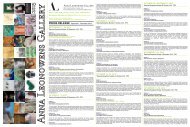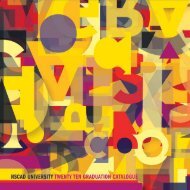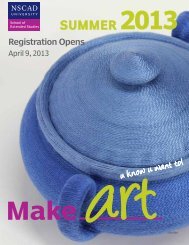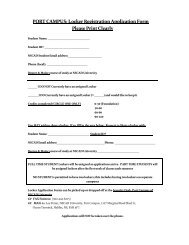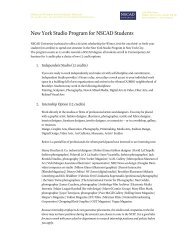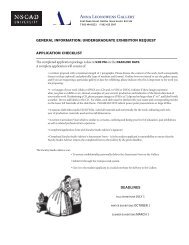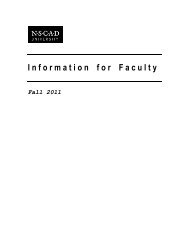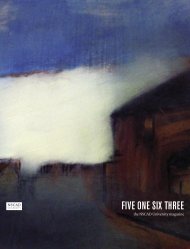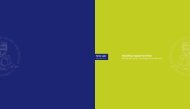NSCAD.Calendar_February 2.FINAL.indd - Nova Scotia College of ...
NSCAD.Calendar_February 2.FINAL.indd - Nova Scotia College of ...
NSCAD.Calendar_February 2.FINAL.indd - Nova Scotia College of ...
Create successful ePaper yourself
Turn your PDF publications into a flip-book with our unique Google optimized e-Paper software.
CERM 4209 Studio Project 2: Ceramics<br />
9 credits (S)<br />
This level <strong>of</strong> independent production <strong>of</strong> studio work expects<br />
students to work toward a body <strong>of</strong> fi nished pr<strong>of</strong>essional work.<br />
Regular critical engagement with the instructor and the class is a<br />
key component. Prerequisites: CERM 4106 or 4109; proposal<br />
CERM 4506 Studio Project 3: Ceramics<br />
6 credits (S)<br />
This level <strong>of</strong> studio engagement expects a high degree <strong>of</strong> self-motivated<br />
work in which students will produce a portfolio <strong>of</strong> pr<strong>of</strong>essional<br />
work. Regular critical engagement with the instructor and<br />
the class is a key component.<br />
Prerequisite: CERM 4206 or 4209 Studio Project 2: Ceramics;<br />
proposal<br />
CERM 4509 Studio Project 3: Ceramics<br />
9 credits (S)<br />
This level <strong>of</strong> studio engagement expects a high degree <strong>of</strong> self-motivated<br />
work in which students will produce a portfolio <strong>of</strong> pr<strong>of</strong>essional<br />
work. Regular critical engagement with the instructor and<br />
the class is a key component.<br />
Prerequisite: CERM 4206 or 4209 Studio Project 2: Ceramics;<br />
proposal<br />
CERM 4606 Studio Project 4: Ceramics<br />
6 credits (S)<br />
This level <strong>of</strong> studio engagement expects a high degree <strong>of</strong> selfmotivated<br />
advanced work in which students will produce a portfolio<br />
<strong>of</strong> pr<strong>of</strong>essional work. Regular critical engagement with the<br />
instructor and the class is a key component. Students must have<br />
a proposal approved by the instructor to register for the course.<br />
Prerequisite: CERM 4506 or 4509 Studio Project 3: Ceramics;<br />
proposal; signature <strong>of</strong> the Chair<br />
CERM 4609 Studio Project 4: Ceramics<br />
9 credits (S)<br />
This level <strong>of</strong> studio engagement expects a high degree <strong>of</strong> selfmotivated<br />
advanced work in which students will produce a portfolio<br />
<strong>of</strong> pr<strong>of</strong>essional work. Regular critical engagement with the<br />
instructor and the class is a key component. Students must have<br />
a proposal approved by the instructor to register for the course.<br />
Prerequisite: CERM 4506 or 4509 Studio Project 3: Ceramics;<br />
proposal; signature <strong>of</strong> the Chair<br />
COMMUNICATION DESIGN<br />
CMDS 2210 [DRAW 2210] Descriptive Drawing<br />
3 credits (S)<br />
The main focus <strong>of</strong> the course is on detailed observation and development<br />
<strong>of</strong> rendering skills through the study <strong>of</strong> objects, materials,<br />
textures and systems <strong>of</strong> perspective.<br />
Prerequisite: FNDN 1600 Foundation Drawing II.<br />
CMDS 2300 Information Graphics<br />
3 credits (S)<br />
An introductory course exploring graphic methods <strong>of</strong> improving<br />
the eff ective communication <strong>of</strong> quantitative and qualitative<br />
information.<br />
Prerequisite: Foundation.<br />
CMDS 2400 Manuscript to Pre-Press<br />
3 credits (S)<br />
This course introduces basic graphic techniques and procedures<br />
<strong>of</strong> the design studio from written word to prepress stage, using<br />
standard s<strong>of</strong>tware. Areas covered include the theory and practice<br />
<strong>of</strong> rough layout and comprehensive presentation, typography,<br />
copywriting, manuscript preparation, paper selection, binding,<br />
halftones, printing, production control and budgetary considerations.<br />
Prerequisite: DSGN 2010, Principles, Theories and Practices <strong>of</strong> 2D<br />
and 3D Design<br />
62<br />
CMDS 2500 Typography<br />
3 credits (S)<br />
This course focuses on specialized technical and aesthetic issues<br />
in Communication Design, emphasizing the inventive use <strong>of</strong> type<br />
and typography for interpreting text.<br />
Prerequisite: FNDN 1450 Studio Practice: Design; FNDN 1350<br />
Foundation Computer; or permission <strong>of</strong> the Division Chair.<br />
CMDS 2600 [DRAW 2600] Steps to Illustration<br />
3 credits (S)<br />
This course concentrates on problems faced by the illustrator in<br />
drawing, technique, media, and preparation <strong>of</strong> art for printing; also<br />
the business <strong>of</strong> being an illustrator.<br />
Prerequisite: 6 credits <strong>of</strong> drawing.<br />
CMDS 3100 [CSTU 3100] Introduction to Semiotics<br />
3 credits (L)<br />
This course surveys various theories <strong>of</strong> signs, especially with relation<br />
to problems <strong>of</strong> visual communication.<br />
Prerequisite: 6 credits <strong>of</strong> LAS at 2000 level<br />
Approved: 18 May 1978; 19 December 1996<br />
CMDS 3150 Perspectives in Graphic Communication:<br />
3 credits (L) [topic]<br />
Students examine selected themes and topics in communication<br />
graphics and information design.<br />
Prerequisite: DSGN 2010 Design Studio 1: Principles, Theories<br />
and Practices <strong>of</strong> 2D and 3D Design; or as specifi ed<br />
Topics<br />
3151 – Maker, Medium, Message<br />
CMDS 3200 Graphic Technology: Digital Pre-Press<br />
3 credits (S)<br />
Students are introduced to pre-press processes by way <strong>of</strong> digital<br />
imaging including scanning, typesetting and colour separations,<br />
and pro<strong>of</strong>i ng. Demonstrations and exercises will also involve input<br />
by industry practitioners.<br />
Prerequisite: DSGN 2500 Principles, Theories and Practices <strong>of</strong> 2D<br />
and 3D Design<br />
CMDS 3300 Graphic Design Workshop: [topic]<br />
3 credits (S)<br />
This course will provide intermediate design experience, allowing<br />
a student to apply acquired knowledge and skills to a selected<br />
topic area.<br />
Prerequisite: DSGN 2500 Principles, Theories and Practices <strong>of</strong> 2D<br />
and 3D Design or as specifi ed<br />
Topics:<br />
3301 – Type and Image<br />
3302 – Computer Applications<br />
3303 – Layout<br />
3304 – Digital Layout<br />
3305 – Designing for Accessibility<br />
3306 – Designing Type<br />
3307 – Art Direction<br />
3308 – Portfolio Development<br />
3309 – Designing Information Systems<br />
3310 – Visualization and Presentation<br />
3311 – Editorial Design<br />
3312- XTHML<br />
3313 - TBA<br />
3314 –NOT IN SIS<br />
3315 – Concept Development<br />
3316 – Web Content Management Systems<br />
3317 - Type<br />
CMDS 3600 [DRAW 3600] Intermediate Illustration<br />
3 credits (S)<br />
This course allows students to enhance their illustration skills.<br />
Students explore advanced techniques and styles and work on<br />
conceptualizing ideas.<br />
Prerequisite: DRAW 2600/CMDS 2600



